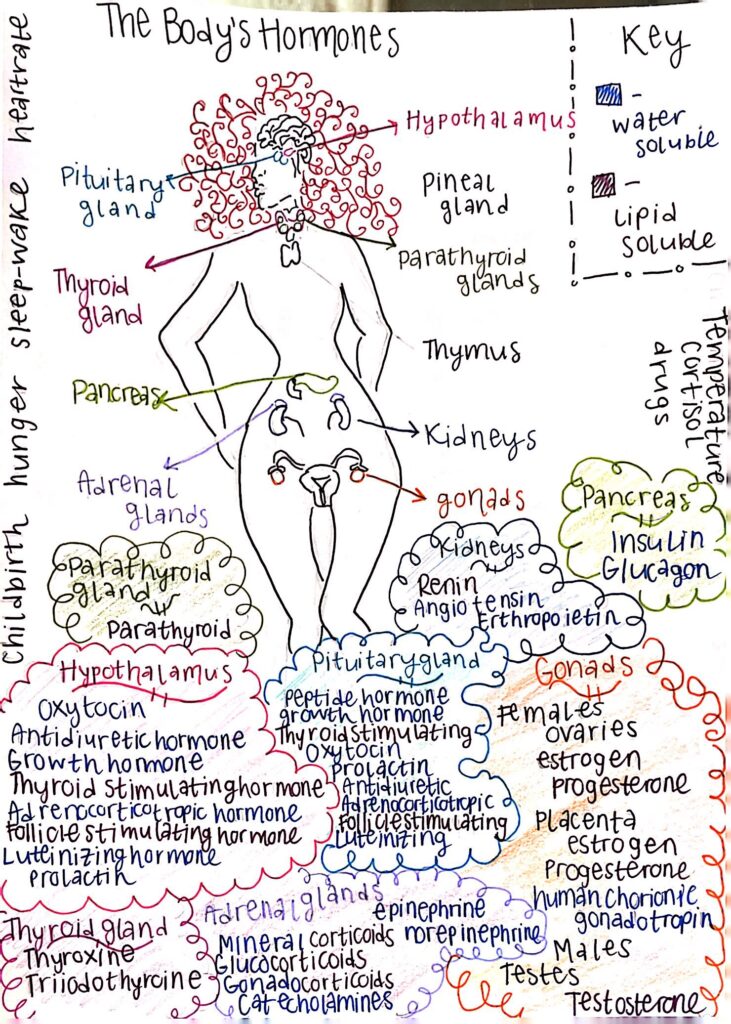Chloe Sears
The Body’s Hormones
The course objective that I picked for my STEAM project, is to categorize the types of hormones. I found this very interesting, as I understand how much it affects your everyday wellbeing, and experience. There are many systems that affect the release of hormones, and even a clock we regulate to. I made sure to include this information along the sides of my project.
In my project, I drew a model of our body, and included the organs that are hormone targets. Attached to each one of these organs, I labeled what hormones are correlated with each section. I also included a key in my project, and this key determines which hormones are water soluble, and which are lipid soluble, and this is labeled by a color coding system.
I believe that my project identifies with the course objective, as it gives a clear map system of where the hormones are, and what type of hormone it is. I know that this project will increase understanding of the objective as it helps with visualizing what is happening in our body, and where each hormone comes from.
There was quite a bit of information I was unable to contain within my project, and this information is regarding the purpose of each hormone. We know that hormones are chemical signals traveling long distances within our blood, and lymph tissue. These hormones can act on target cells, or tissues with specific hormone receptors. We have amino acid based hormones that consist of peptides and proteins. We also have steroids that are synthesized from cholesterol including gonadal, and adrenocortical hormones. What I labeled and identified in my project is the water soluble hormones, and the lipid soluble hormones. Water soluble hormones are free in plasma, and act on plasma membrane receptors, and use G protein, and are unable to enter the cell, and have a short half life due to the kidney. Lipid soluble hormones are bound to proteins within the plasma, and have a long half life due to the liver, and are able to enter the cell.
Within the gonads, in females estrogen, and progesterone are what mature reproductive organs, and cause the appearance of secondary sexual characteristics, and cause breast development and cyclical changes of uterine mucosa. In males, testosterone in the testes is what causes the maturation of reproductive organs, and causes them to be functional. Testosterone is also what causes normal sperm production.
Within the Adrenal glands, mineralocorticoids target our kidney and increase sodium ions, and decrease potassium ions. It also causes a rise of blood volume, and pressure. Glucocorticoids promote gluconeogenesis and hyperglycemia, and mobilize body fats in order to utilize energy, and therefore help regulate metabolism. This hormone is able to stimulate protein catabolism,and helps our body to resist stressors, and also depresses our immune and inflammatory responses. Gonadocorticoids in females only contribute to libido and growth of pubic hair, and after menopause if the source of estrogen. In the adrenal glands we also see catecholamines, which are epinephrine, and norepinephrine. These hormones target our sympathetic nervous system and increase our heart, and metabolic rate.
Within the Hypothalamus we see many hormones including oxytocin that can stimulate uterine contractions and milk production. We also have antidiuretic hormone that targets our kidneys to reabsorb water and is triggered by pain, and low blood pressure.
In conclusion, I really appreciate you taking the time to read my essay,and view my project. I hope it is found to be informative, and hopefully increase knowledge on the topic. I find the hormones of our body to be fascinating. A delicate system of chemicals that affects almost everything we feel, and how our body develops.
Sources
Lecture Notes Endocrine System
Endocrine Society. (2022, March 31). Hormones and endocrine function. Endocrine Society. Retrieved April 20, 2023, from https://www.endocrine.org/patient-engagement/endocrine-library/hormones-and-endocrine-function
Hiller-Sturmhöfel, S., & Bartke, A. (1998). The endocrine system: An overview. Alcohol health and research world. Retrieved April 20, 2023, from https://www.ncbi.nlm.nih.gov/pmc/articles/PMC6761896/
Holst, J. P., Soldin, O. P., Guo, T., & Soldin, S. J. (2004, March). Steroid hormones: Relevance and measurement in the clinical laboratory. Clinics in laboratory medicine. Retrieved April 20, 2023, from https://www.ncbi.nlm.nih.gov/pmc/articles/PMC3636985/
Hormones and the endocrine system. Hormones and the Endocrine System | Johns Hopkins Medicine. (2019, November 19). Retrieved April 20, 2023, from https://www.hopkinsmedicine.org/health/conditions-and-diseases/hormones-and-the-endocrine-system Libretexts. (2022, June 9). 37.2: Types of hormones – lipid-derived, amino acid-derived, and peptide hormones. Biology LibreTexts. Retrieved April 20, 2023, from https://bio.libretexts.org/Bookshelves/Introductory_and_General_Biology/Book%3A_General_Biology_(Boundless)/37%3A_The_Endocrine_System/37.02%3A_Types_of_Hormones_-_Lipid-Derived_Amino_Acid-Derived_and_Peptide_Hormones


Chloe’s course objective is the categorization of the types of hormones. Chloe drew a model of the body with organs corresponding to their hormones. In Chloe’s drawing they have listed each organ and then made lists of each hormone that is produced by the organ. Within the drawing, they even categorized water soluble and lipid soluble hormones. As well as Chloe has categorized hormones that are produced differently for male and females via the gonads.
In the body of text Chloe has described what hormones are, how they are made, and how they travel throughout the body. Chloe then lists how amino acid-based hormones work, how water-soluble hormones work, and lipid soluble hormones. Chloe goes into further detail of how each hormone works such as estrogen, testosterone, mineralocorticoids, and glucocorticoids.
Chloe not only met the objective of categorizing the hormones, but goes into further detail of discussing the hormones, how they are made, and how they work. She has produced a very informative STEAM project that will help any student needing help with hormones.